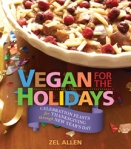 PEAR CRANBERRY COMPOTE WITH CHOCO-WAFERS
PEAR CRANBERRY COMPOTE WITH CHOCO-WAFERS
Holiday meals, whether at home or at my grandmother’s, always concluded with a small bowl of stewed dried fruits cooked until soft and perfectly sweetened and pleasantly laced with cinnamon. It certainly wasn’t a fancy dessert, and it’s probably one of the most unpretentious desserts one can offer guests at the end of a special celebration. Yet, the memories continue to bring sweet thoughts. When I close my eyes, I can almost taste those dried prunes, apricots, pears, and raisins and remember fondly the definitive spicy aroma of cinnamon that made me appreciate this simple homespun dessert.
Because the compote was sweet and generously spiced with cinnamon, I remembered this dessert fondly and as a kid, I always looked forward to it. It became one of those tiny little treasures I knew Grandma would bring to the table without fail.
I thought it might be lovely to pass on those memories to others with a compote that’s just as easy to make, but with something special in addition that would elevate it to become a truly elegant treat. So I began with fresh pears and fresh cranberries rather than dried and spiced it with just enough cinnamon to add that nostalgic holiday aroma. But it was still just a simple compote. What else could I do to make it really zing?
 Voila! Homemade Choco-Wafers turned this delicious, unpretentious compote into an elegant, alluring dessert with a built-in convenience factor. These delicious little wafers can be made several days ahead and refrigerated until ready to serve. They actually keep well for up to three months in the fridge. I might also mention this is one of the delicious holiday desserts in my Vegan for the Holidays Cookbook!
Voila! Homemade Choco-Wafers turned this delicious, unpretentious compote into an elegant, alluring dessert with a built-in convenience factor. These delicious little wafers can be made several days ahead and refrigerated until ready to serve. They actually keep well for up to three months in the fridge. I might also mention this is one of the delicious holiday desserts in my Vegan for the Holidays Cookbook!
The compote can be prepared two days ahead and tucked into the fridge until dessert time. But, to make this dessert extra special and give your guests that pampered feeling, bring it to room temperature on serving day and gently warm it at 350 degrees F. for about 10 to 15 minutes just before serving.
At serving time, spoon the compote into little dessert dishes and tuck two Homemade Choco-Wafers into the dish so they stand tall. Sometimes I place the wafers on the sides and sometimes in the center. Maybe you’ll come up with an even more dramatic way of presenting this dessert–there’s plenty of room for creativity!
 PEAR CRANBERRY COMPOTE WITH CHOCO-WAFERS
PEAR CRANBERRY COMPOTE WITH CHOCO-WAFERS
Yield: about 6 servings
Choco-Wafers
1 cup pitted dates, snipped in half
1/4 cup plus 1 tablespoon water
3 tablespoons golden raisins
3 tablespoons plus 1 teaspoon unsweetened cocoa powder
Compote
2 fresh Anjou or Bosc pears, cored, quartered, and sliced
1 cup fresh cranberries
1/2 cup plus 1 tablespoons light brown sugar, firmly packed
1/3 cup black raisins
1/4 cup plus 2 tablespoons freshly squeezed lemon juice
1/2 teaspoon ground cinnamon
1/2 teaspoon vanilla extract
1/4 cup water
1 tablespoon cornstarch
3 tablespoons coarsely ground toasted, walnut, almonds, or hazelnuts, for garnish
- TO MAKE THE CHOCO-WAFERS, preheat the oven to 350 degrees F. Line a 17 1/2 x 12 1/2-inch rimmed baking sheet with parchment paper.
- Put all the wafer ingredients in a food processor. Process until all the ingredients are well incorporated, the nuts are broken down to a fine, but slightly textured meal, and the mixture reaches a very thick, finely mashed, firm consistency, stopping occasionally to scrape down the workbowl.
- Spoon the wafer mixture into the prepared baking sheet and use the back of the spoon to form it into a 1/4-inch thick rectangle approximately 8 inches by 9 inches.
- Bake for 15 to 20 minutes, or until the wafer is set and almost dry to the touch but still soft. Remove from the oven and let cool completely. It will firm as it cools. When cool, cut into 2 or 3-inch squares and set aside until ready to serve or put the squares in a ziplock bag and refrigerate.
- TO MAKE THE COMPOTE, combine the pears, cranberries, brown sugar, raisins, lemon juice, cinnamon, vanilla, and water in a 3 or 4-quart saucepan. Cover and bring to a boil over high heat. Immediately, decrease the heat to low, and simmer 10 minutes, or until the pears are softened.
- To thicken the juice in the pan, combine the cornstarch and 1 tablespoon water in a small cup or bowl and stir until smooth. Stir the paste into the simmering compote a little at a time, stirring constantly for about 1 minute, or until thickened to desired consistency.
- To serve, spoon the compote into small dessert dishes and garnish each with the walnuts, if desired. Tuck 2 wafers into the center or sides of the compote.











